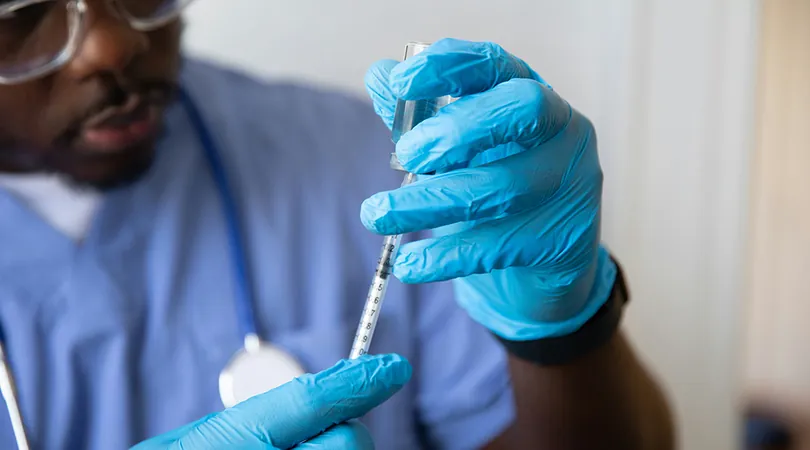
Revolutionary Vaccination Technique Promises Safer and More Effective Immunization
2024-10-14
Author: Sarah
Introduction
In an exciting development in vaccine technology, researchers are redesigning vaccine formulations to improve their safety and effectiveness, particularly for protein subunit vaccines. These innovative vaccines utilize harmless fragments from viruses or bacteria to provoke an immune response, while simultaneously minimizing the need for adjuvants—substances that enhance immune responses.
Traditional Vaccine Approaches
Traditionally, vaccines introduce an antigen, such as a pathogen protein, into the immune system, prompting immune cells to recognize and prepare to combat future exposures. However, many modern vaccines incorporate adjuvants, such as CpG, a genetic sequence found in various pathogens but not in humans. While CpG boosts immune responses, it also carries the risk of inducing serious side effects, particularly when administered through inhalation—a common method for targeting respiratory pathogens.
Innovative Method from Beijing Institute of Biotechnology
Researchers from the Beijing Institute of Biotechnology have created a groundbreaking method that directly links the protein subunit of a vaccine to the CpG adjuvant. By doing so, they significantly reduce the amount of CpG required, thereby improving the safety profile of vaccines designed for conditions like human papillomavirus (HPV) and hepatitis B.
Expert Insights
"Reducing the dose of CpG adjuvants is essential for developing inhaled vaccines and mitigating their side effects," emphasizes Li Zhu, a lead researcher.
Targeting the Lungs
The new approach targets the lungs, the primary battleground for respiratory infections like influenza and SARS-CoV-2. By aerosolizing vaccines, they can effectively reach the mucosal cells that line the respiratory tract. However, conventional vaccine formulations often cause overwhelming immune responses in these sensitive cells when the adjuvant and the antigen are administered separately. The innovative method adopted by Zhu and her team aims to ensure that immune cells are exposed to both components concurrently by binding the antigen directly to the adjuvant.
Challenges in Linkage
Achieving this precise linkage, however, is more intricate than it appears. Any misalignment in the attachment can block critical binding sites, undermining the vaccine's effectiveness. Hengliang Wang, another team member, aptly explains that the antigen functions as a mold for antibody production; if improperly shaped, the resulting antibodies cannot perform their immune role effectively.
Spy-Catcher/SpyTag System
To overcome these challenges without resorting to time-consuming and complex chemical methods, the researchers employed the Spy-Catcher/SpyTag system—a kind of biological adhesive that simplified the linking of the antigen and adjuvant.
Laboratory Confirmation
This technique is reminiscent of a concept employed in an existing cancer treatment that targets tumor cells, prompting an immune response. By marrying their antigen-adjuvant link with principles from this cancer treatment, the researchers were able to confirm through laboratory tests that their new vaccine components successfully bind at the designated sites, forming a potent antigen-adjuvant complex.
Safety and Efficacy Enhancements
"Our method not only allows for reduced adjuvant dosage, enhancing safety, especially for inhaled vaccines, but also ensures the appropriate structural integrity of the antigen," Zhu states.
Future Directions
The ease and efficiency of using components like Spy and DVC promise high uniformity in production, preparing the ground for future mass vaccination efforts. Looking ahead, Zhu revealed that the next phase of research will focus on developing aerosolized or powdered formulations to evaluate different dosages and their efficiency. The ultimate goal? To test this cutting-edge vaccine system in primate models and pave the way for clinical applications.
Global Implications
The implications of this research are profound, not just for countries currently grappling with infectious disease outbreaks but also for global pandemic preparedness, positioning this innovative approach as a potential game changer in the field of immunization.
Conclusion
Stay tuned for further updates on this groundbreaking technology that could redefine our approach to vaccines!




 Brasil (PT)
Brasil (PT)
 Canada (EN)
Canada (EN)
 Chile (ES)
Chile (ES)
 España (ES)
España (ES)
 France (FR)
France (FR)
 Hong Kong (EN)
Hong Kong (EN)
 Italia (IT)
Italia (IT)
 日本 (JA)
日本 (JA)
 Magyarország (HU)
Magyarország (HU)
 Norge (NO)
Norge (NO)
 Polska (PL)
Polska (PL)
 Schweiz (DE)
Schweiz (DE)
 Singapore (EN)
Singapore (EN)
 Sverige (SV)
Sverige (SV)
 Suomi (FI)
Suomi (FI)
 Türkiye (TR)
Türkiye (TR)